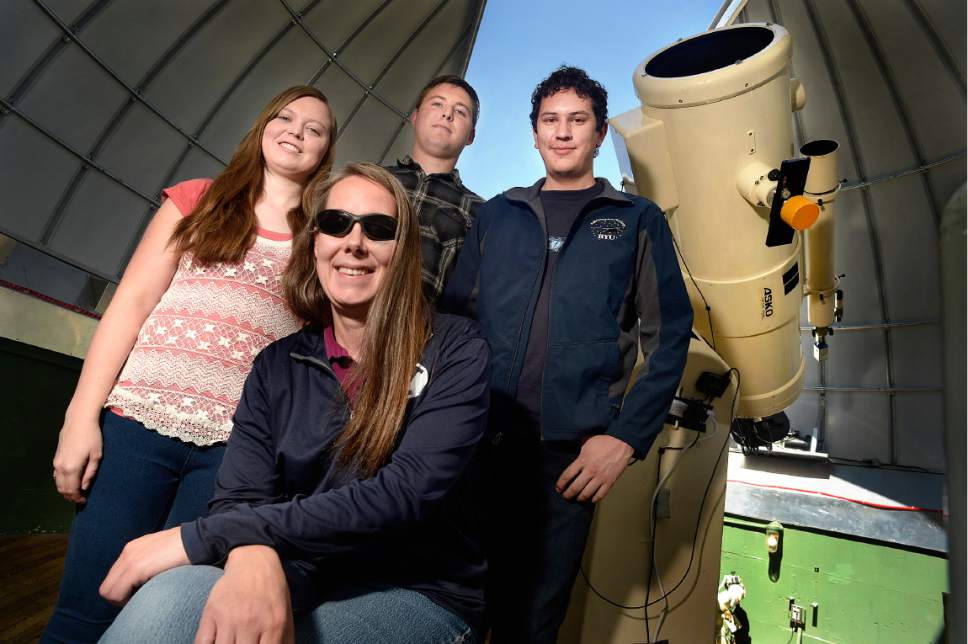This is an archived article that was published on sltrib.com in 2017, and information in the article may be outdated. It is provided only for personal research purposes and may not be reprinted.
Provo • A group of recent Brigham Young University graduates can already put "discovered a planet" on their resumes.
A paper describing their first discovery, the planet KELT-16b, was published shortly before they completed their bachelor's degrees at BYU this spring. They're now training the Provo school's next generation of planet finders.
Kyle Matt, one of the team's first members, describes KELT-16b as being larger than Jupiter, but located closer to its star than Mercury — so close that it takes less than one Earth day for it to orbit its sun. So close, in fact, it will eventually crash into that star.
As unusual as it is for anyone to find a new planet, it's even less likely for undergraduates to participate in the discovery, said Denise Stephens, an associate professor in BYU's Physics and Astronomy department.
Research at universities is typically conducted by professors and graduate students. And the discovery was doubly unlikely at BYU, which has a only a relatively small telescope at its disposal. But it was the small telescope that inspired Stephens to have her students begin looking for planets.
Stephens came across the KELT project, a planet-hunting consortium involving teams at other universities, while looking for research she could conduct with BYU's limited astronomy tools. The Utah native had returned to BYU from Johns Hopkins University, where she had been conducting research with infrared telescopes — equipment not easily available to her at BYU.
But KELT needed help looking for planets, and that, she thought, she could do.
The KELT project — short for Kilodegree Extremely Little Telescope — involves two robotic telescopes, located in Arizona and South Africa, that scan the night sky and take a picture whenever something appears to pass in front of a star, causing the star's light to dim.
The coordinates of those stars are then sent to some 40 cooperating teams, which use their own telescopes to monitor the stars for patterns in the star's light that suggest a planet may be present. The star might dim at a regular interval, for example, coinciding with the planet's orbit.
BYU joined the effort in 2015 and assigned groups of undergraduates to follow up on KELT's suggestions, monitor candidate stars and analyze the data they collected.
"It's not something they can't do," Stephens said, "but you have to give them the opportunity."
Once they mastered key skills, students used the small BYU telescope to locate prospect stars and used computer software to collect images. Leeanne Farnbach, the BYU astronomy student who was in charge of operating the telescope the night they first observed KELT-16b, said most nights' work amounted to "pointing the telescope at a target and doing homework."
Taking tips from KELT doesn't guarantee a discovery, Stephens said. The BYU group vets about 50 targets per year, and so far, has confirmed one planet.
Most of the targets, she said, end up being binary star systems — where two stars orbit each other — or other non-planetary phenomena.
When a probable planet does crop up, Stephens said, BYU had to race other KELT teams to be the first to collect enough data to claim the discovery as their own. Meanwhile, Stephens said her groups had to contend with equipment failures and a steep learning curve.
"There were many times when I was going to throw in the towel and say, 'Forget it, it's not worth it,' " she said. "You'd spend all night and by the time you got [the equipment] working, you'd find out someone else had already observed your target."
Andrew Patterson, another BYU student who worked on the project, said it was a good lesson in problem solving and persistence. When a third party telescope provided the data on KELT-16b's size and composition in 2016, Patterson said it felt like proof that they were up to the task.
"Oh yeah, it's a giant planet," Patterson said he remembered thinking. "We can find these."
Though a hot gas giant with virtually no chance of sustaining life, KELT-16b is of interest for other reasons.
It's unlikely that a planet so large could have formed in the solar system where it's currently located, Stephens said, and it could yield clues on how planets form and interact with one another.
Its BYU discoverers Patterson, Farnbach and Matt all graduated last week and will be leaving the school.
Matt intends to attend graduate school at Montana State University, where he will continue his astronomy studies. Patterson plans to go to work for his family's Utah-based home construction business, and Farnbach will be moving to Texas, where she will look for work related to astronomy.
Meanwhile, Stephens said she and others are busy training a new batch of first-year planet-hunters with plans to continue the search, a mission she described as a "baby step in the search for life."
Her team is already close to confirming a second planet and Stephens said she expects to find more in the future.
Twitter: @EmaPen



